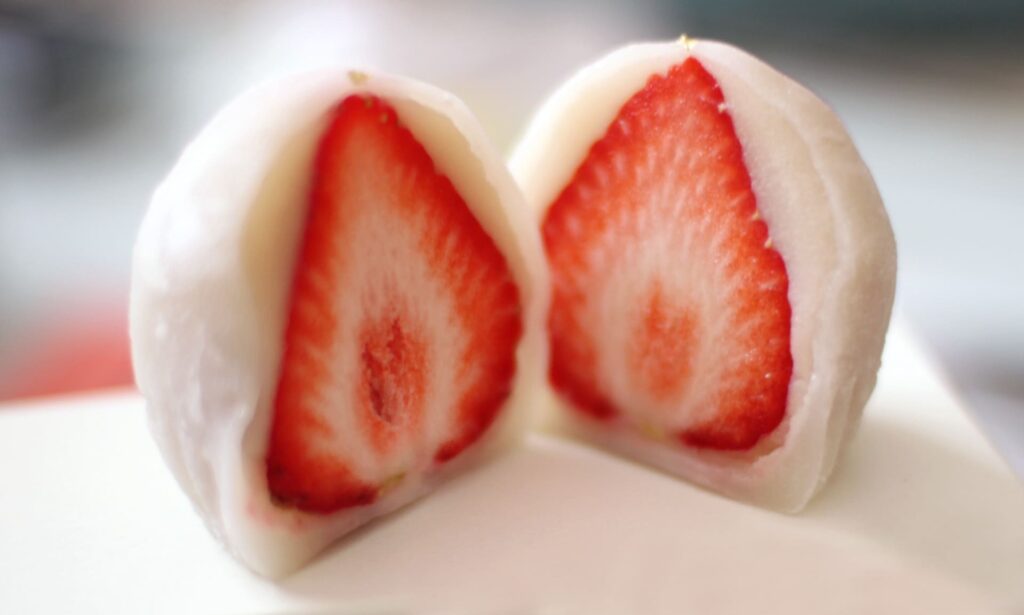
Welcome to Spoonful of Asia! We turn those addictive food videos you can't stop watching into real recipes you can make at home. Been seeing those cute strawberry daifuku (also called ichigo daifuku) all over TikTok or YouTube Shorts? You're in the right place! These soft mochi balls filled with sweet bean paste and fresh strawberries don't need to stay in your "saved" folder – they belong in your kitchen!
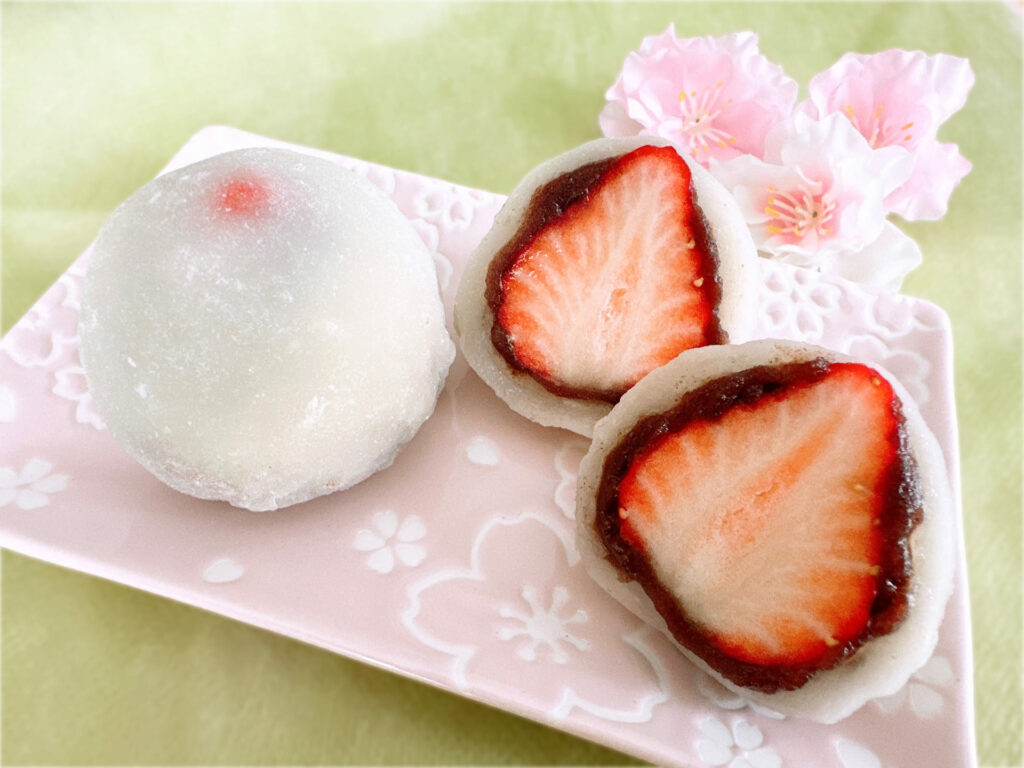
I know how it feels to juggle work, family, and the daily "what should I cook?" question. That's why I made Spoonful of Asia – to break down viral Asian recipes into clear, simple steps. No more tossing your spatula across the kitchen in anger!
The strawberry daifuku we're sharing today is taking social media by storm. These Japanese treats mix chewy mochi with juicy strawberries and rich bean paste. They're not just desserts – they're tiny bundles of joy that will make you feel like a master chef without flying to Tokyo or spending tons of money at fancy bakeries.
Let's start with a quick lesson before we dive into the strawberry goodness! Those cute puffy white balls taking over your feeds are called daifuku mochi. They've been around for about 250 years – way longer than TikTok!
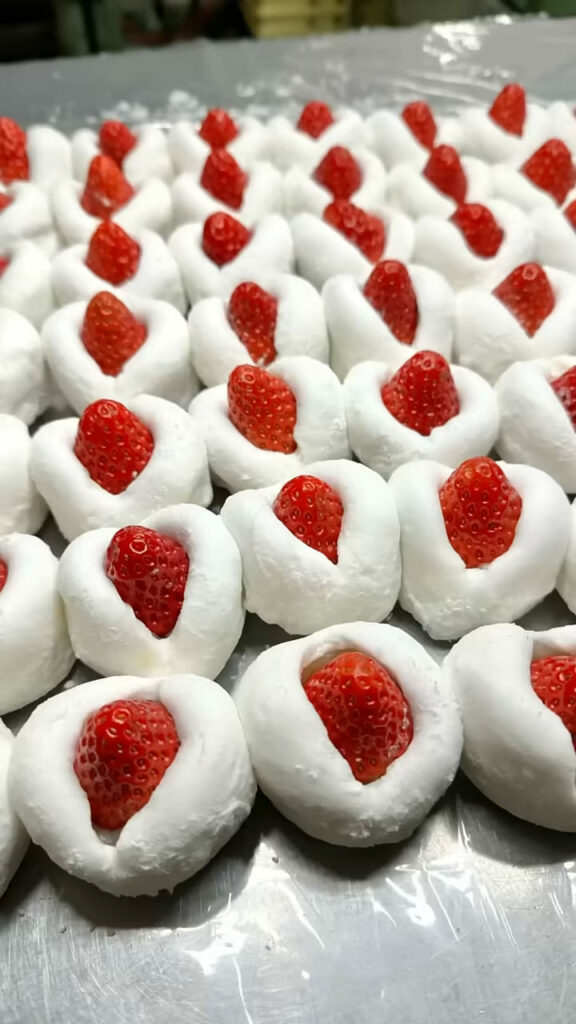
Daifuku (大福) means "great fortune" in Japanese. No wonder I feel so lucky when I bite into one! These sweet treats are soft mochi (rice cake) wrapped around a filling, often sweet red bean paste called "anko." Think of them as Japanese dessert sandwiches – but instead of bread, you get that chewy, stretchy mochi that's perfect for food videos.
While plain daifuku are tasty, the strawberry kind – ichigo daifuku – takes these treats to a whole new level. Imagine biting through that soft mochi layer, finding sweet bean paste, and then the juicy pop of a fresh strawberry inside!
What makes strawberry daifuku so special is how the textures play together. The chewy mochi, smooth bean paste, and juicy berry create a mix of feelings that explain why people love making videos of these treats. They're not just yummy; they're an event!
The best part? Despite looking fancy, mochi daifuku are pretty easy for home cooks. You need just a few things, and while there's a trick to making them, any mom with a sweet tooth and 30 minutes can master it. Plus, making them at home means you control how sweet they are. This is perfect for when you want a treat but are trying to cut back on sugar after a long day of emails and kid drama.

If your social feeds are full of these cute rice cakes, you're not alone! Strawberry daifuku has gone from old-school Japanese sweet to global hit faster than you can say "add to cart." But what's behind this mochi craze that has everyone from food stars to your PTA friends trying these sweet treats?
First, let's be honest – they're super pretty. In a world where we eat with our eyes first (and our phones second), strawberry daifuku looks amazing in photos. That smooth, powdery white outside with a perfect red strawberry inside is made for viral videos.
Beyond being Instagram-ready, strawberry daifuku hits the sweet spot of many food trends. They're plant-based (though not always vegan) and more natural than many desserts. They have that touch of "exotic" that makes us feel worldly in our own kitchens. Plus, there's something great about a dessert you can hold, that comes in its own portion, and needs no fork. This is perfect for busy moms who often eat standing up while solving kid fights over screen time.
The pandemic also helped daifuku gain fans. As more people stayed home with time to try new recipes, Japanese desserts offered a fun challenge. Making mochi became one of those doable kitchen projects – more wow-factor than banana bread but less scary than sourdough. And unlike some tricky baking, strawberry daifuku often turns out looking like the videos.
For health-minded folks, strawberry daifuku offers a better dessert choice. While I won't claim they're health food (they're still treats!), they're less processed than many Western sweets. They come in built-in small sizes, and hey – they've got real fruit! When you want to make better choices while still having something sweet, ichigo daifuku hits that middle ground. It's the perfect balance between saying no to treats and diving into a whole tub of ice cream.
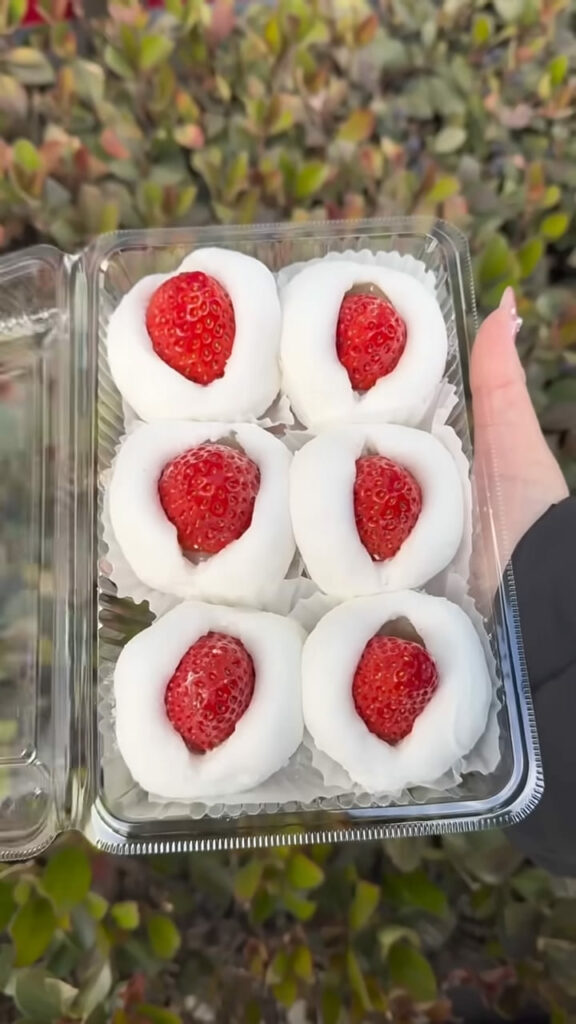
Let's talk about the star of our strawberry daifuku show – the mochi itself! This stretchy, chewy rice cake might seem magic if you've only had store-bought ones. But making good mochi at home is totally doable. Once you master it, you'll find yourself showing off your new skill. "Oh, you brought store cookies to the playdate? How... cute. I just made fresh mochi this morning." (But maybe keep that smug thought to yourself!)
The base of any good mochi is sweet rice flour, also called glutinous rice flour. Despite its name, it has no gluten. The "glutinous" just means it gets sticky and stretchy when cooked. The most common types for daifuku are Mochiko or Shiratamako. They might sound fancy, but many regular grocery stores now carry Mochiko in the global foods aisle, and if not, you can find it online.
The magic of mochi happens when you cook this simple mix of rice flour, sugar, and water. It starts as a thin, milky mix and turns into that stretchy, soft dough that makes daifuku so special. In the past, making mochi was hard work. People pounded steamed rice using wooden hammers in a ritual called mochitsuki. Lucky for us, home cooks now have easier ways – you can use a microwave or steam it on the stove.
The hardest part of making mochi isn't cooking it but handling the dough after. Fresh mochi is super sticky – like trying to deal with a toddler who just found maple syrup. This is when potato starch (or cornstarch if you don't have it) becomes your best friend. A good coating stops the mochi from sticking to everything it touches. This includes your fingers, the counter, and somehow your phone screen even though you never touched it.
Heat also plays a big role in working with mochi. Too hot, and you can't touch it; too cool, and it gets stiff. The sweet spot is warm but not hot – just cool enough to handle without saying words you don't want your kids to repeat at school. Here's a pro tip from someone who learned the hard way: work fast! Mochi doesn't wait, and it gets harder to work with the longer it sits.
With practice, you'll get a feel for perfect mochi. It should be soft and stretchy like a yoga pro, but firm enough to hold its shape around the filling without tearing. When you make that perfect batch, it feels amazing. There's something really rewarding about mastering this ancient food. It connects you to a cooking tradition while making you look like a kitchen wizard to friends and family.
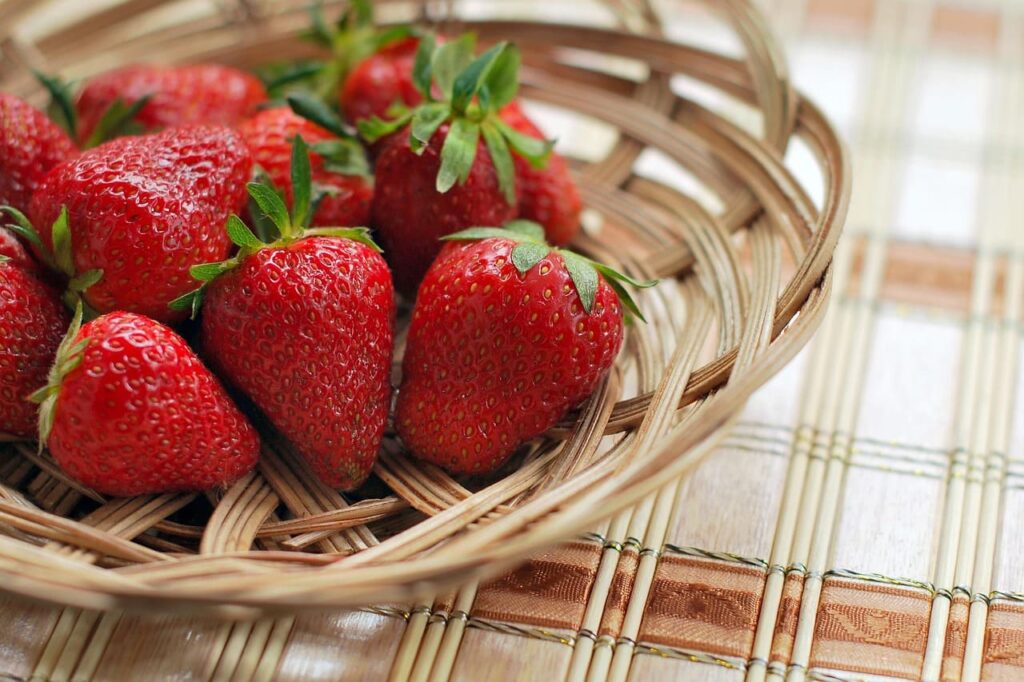
Now let's talk about what makes strawberry daifuku truly special – that magic mix of sweet red bean paste and fresh strawberries. This combo creates a flavor and texture that's so good, you'll wonder why strawberries and beans aren't paired more often. (Actually, let's just keep it to this one case!)

First up: anko, or sweet red bean paste. If you've never tried it, you might doubt beans belong in dessert. Trust me, I was once a doubter too – until that first life-changing bite proved that beans can be sweet and amazing. Made from azuki beans cooked until soft and then sweetened, anko has a rich, earthy sweetness. It's less sugary than many Western dessert fillings.
While you can make your own anko from scratch (a project for another day), busy home cooks can use store-bought red bean paste. You'll still make great strawberry daifuku this way. Look for it in Asian grocery stores or online – it usually comes in cans or sealed packs. There are two main kinds: smooth paste (koshian) and chunky paste with visible beans (tsubuan). Either works well in ichigo daifuku, though the smooth kind is easier for beginners.
Now, for the star – the strawberry! Not just any strawberry works for perfect daifuku. You want berries that are just right: medium-sized (about 15g each), ripe but firm, and similar in size for even daifuku. Too big, and they'll break through your mochi; too small, and you'll miss out on that juicy center. Remember – these strawberries will be the star, so don't use those sad, white-centered winter berries that taste like nothing.
Prepping your strawberries right makes a big difference. They should be well washed, fully dried (water is bad for mochi!), and with the green parts removed. Some ichigo daifuku recipes say to keep a bit of the stem for looks. But for easy eating, fully trimmed berries work best.
The magic happens when you bring these parts together. The sweet earthy anko balances the bright, juicy strawberry, all wrapped in that soft, chewy mochi blanket. It's a taste and texture treat that's better than the sum of its parts. This explains why strawberry daifuku has won food lovers worldwide. And the best part? When you cut into one of your homemade daifuku and show that perfect cross-section with the bright red strawberry center, you'll feel like a food star. Even if the only fans are your family or your judgy cat watching from across the kitchen.
While strawberry daifuku (ichigo daifuku) might be the star of your social feeds, the world of mochi daifuku has many more options! Once you learn to work with mochi dough, you can try loads of daifuku types. These are perfect for when you have other fruits or just want something new.
Old-school daifuku just has the sweet red bean paste filling with no fruit. This classic version is a great first step into daifuku. It focuses on the contrast between the chewy mochi outside and the sweet anko inside. If you're feeding picky eaters (like kids who suddenly "hate" foods they loved yesterday), this simpler kind might be easier to like than one with fruit.
But why stop at strawberries when it comes to fruit fillings? Many fruits can get the daifuku treatment, making what looks like a collection of edible jewels! Mango daifuku offers tropical sweetness that goes great with white bean paste instead of red. Blueberry daifuku makes a pretty purple burst when you bite into it. Even grape daifuku has fans, though peeling those tiny fruits takes more patience than putting together furniture with missing parts.
In fall, persimmon daifuku celebrates the season with its lovely orange color and honey-like sweetness. For summer parties, watermelon daifuku not only tastes fresh but looks amazing when cut open. Just think of the "wows" at your next block party when you show up with these instead of the usual pasta salad!
The filling options go beyond fruits, too. Chocolate daifuku mixes Eastern and Western dessert styles by wrapping mochi around a chocolate center. Matcha daifuku adds green tea powder to either the mochi wrapper or the filling. This creates an earthy, slightly bitter contrast to the sweet taste. Some modern types even have ice cream centers, though these need freezing and have their own challenges (and tasty rewards!).
For those trying to eat less sugar, daifuku can also be made with other fillings. Plain nut butters or even savory options work well. While not traditional, these changes make daifuku work for different diets and tastes. After all, food traditions grow and change, and your kitchen could be where the next great daifuku idea starts!
What makes daifuku so special is how the basic idea – a soft mochi outside with a tasty filling – can be changed in endless ways. It's like having a favorite outfit that you dress up differently based on the event. The mochi is still the star with its unique texture. But the filling lets you be creative and use what's in season or what you like best.
Now that you're ready to make your own viral-worthy strawberry daifuku, let's talk strategy! Even with our step-by-step recipe, these ninja-level tips can take your mochi game from "pretty good" to "why don't you have your own cooking show?" Think of this as your cheat sheet to ichigo daifuku success!
First and most important, get everything ready before you start. Unlike forgiving recipes where you can chop as you go, mochi won't wait. Once it's cooked, you need to work quickly before it cools and gets stiff. Set up your workspace like a pro – potato starch for dusting, bean paste ready to use, strawberries prepped, and all tools within reach. Think of it like meal prep, but with the rush of a cooking show without the dramatic music (unless you want some – no judging here!).
Speaking of strawberries, here's a game-changer: after washing and fully drying your berries, roll them lightly in a bit of sugar before wrapping. This not only makes them sweeter but also pulls out some juice. This creates a stronger strawberry flavor in the center. Just a light coating will do – we're making the fruit taste better, not turning it into candy.
When working with anko (red bean paste), slightly chilled paste is easier to handle than room temp. About 15-20 minutes in the fridge will firm it up just enough. This makes it more workable when you're trying to wrap it around strawberries. And here's a trick from pro Japanese pastry chefs: flatten your anko into a disc before wrapping it around the strawberry. This works better than trying to mold a ball of paste around the fruit. It makes a more even layer and reduces the chance of tearing.
Heat control matters for the mochi too. While it needs to be warm enough to stay pliable, working with slightly cooled mochi gives you more control. It should be just cool enough to handle without burning your fingers. If your mochi is cooling too fast as you work, try this: take a clean kitchen towel, dampen it with warm water, wring it out, and place it over your mochi. This keeps it warm – like tucking it in for a cozy nap while you work with each piece!
Don't be stingy with the potato starch for dusting. Yes, you'll want to brush off extra before serving. But during the wrapping process, plenty of dusting stops the sticky nightmare where your nicely wrapped daifuku sticks forever to your counter. Think of potato starch as the fairy godmother of mochi-making – it keeps everything from turning into a pumpkin at midnight, or in this case, a sticky mess at snack time.
Finally, a serving tip that makes all the difference: strawberry daifuku taste best when they rest for about 30 minutes after making them. This short wait lets moisture from the mochi slightly soak into the anko. The flavors blend perfectly this way. It's like letting a friendship grow naturally instead of forcing it – the results are so much better with a little patience!
And remember, even if your first batch doesn't look perfect for Instagram, they'll still taste amazing. Making mochi is part art, part science, and each batch teaches you something new. Soon, you'll be the daifuku expert among your friends. You'll get requests to bring your signature strawberry daifuku to every party. Just don't be surprised when friends start "just stopping by" right around when they know you might have fresh daifuku cooling on the counter!
In a world where quick and easy often beats homemade, and food delivery is just a tap away, you might wonder: why bother making strawberry daifuku from scratch? Sure, you could maybe find them at a fancy bakery or Asian market (if you're lucky enough to live near one). But there's something special about making these little mochi treasures in your own kitchen that goes beyond just having a sweet treat.
First, let's talk money – because who doesn't love saving? Store-bought daifuku can be really pricey, often $3-5 each at special shops. Make them at home, and each one costs about $0.75-1.00, which means your family's dessert habit just got 75% cheaper. That's money you can spend on other things. Maybe that fancy coffee maker you've been wanting? Or your child's college fund? (Or, let's be real, more baking stuff).
Beyond saving money, homemade ichigo daifuku lets you control what goes in them. Many store-bought ones have preservatives, fake colors, and tons of sugar. When you make your own, you can make them as sweet as you like. You can use organic strawberries if that matters to you. And you know exactly what your family is eating. It's clean eating with a touch of treat – the perfect balance we're all trying to find!
There's also the freshness factor. Mochi is at its very best when freshly made. It has that perfect soft and chewy texture that changes over time. Store-bought daifuku just can't match the texture of mochi made the same day you eat it. It's like comparing fresh-baked bread to something from a shelf. They might be technically the same food, but they're worlds apart in how they taste and feel.
Making strawberry daifuku at home also gives you a fun way to connect with family or friends. It's a great kitchen project to do with kids (with proper help, of course) or as an activity during a girls' night in. There's something social about food prep that involves hands-on assembly. Talks flow naturally, laughs break out over funny-shaped attempts, and memories form along with the treats themselves.
Maybe most important is the huge satisfaction that comes from creating something pretty and tasty with your own hands. In our screen-filled world where so much of what we do exists only online, making something real gives a special kind of joy. That moment when you finish your first perfectly round strawberry daifuku brings a sense of pride that ordering takeout just can't match. Your mochi has that smooth outside hiding the perfect mix of anko and fruit. It's an achievement worth celebrating!
So yes, making strawberry daifuku takes some work and a willingness to get a little messy. But the results make it well worth it. You get the tasty treats plus the good feelings of creativity, connection, and pride in your cooking skills. Plus, you get serious bragging rights when you casually say, "Oh, these ichigo daifuku? I just made them this morning" at your next get-together!
Now that you're all fired up to create your own strawberry daifuku masterpieces, it's time to roll up your sleeves and get that mochi started! We break down the process into easy steps that even first-time mochi makers can follow with confidence.
With simple ingredients and clear steps, you'll be enjoying these soft, sweet, strawberry-filled bundles of joy before you know it!
And remember, the path to perfect strawberry daifuku might include a few sticky situations (literally), but the yummy results are worth every bit of effort. And once you've mastered these treats, you'll have a signature homemade dessert that's sure to impress anyone lucky enough to try it!
| Ichigo Daifuku is a delightful Japanese sweet made with chewy mochi dough, sweet red bean paste, and fresh strawberries. It's a viral dessert that’s both beautiful and surprisingly simple to make at home. |